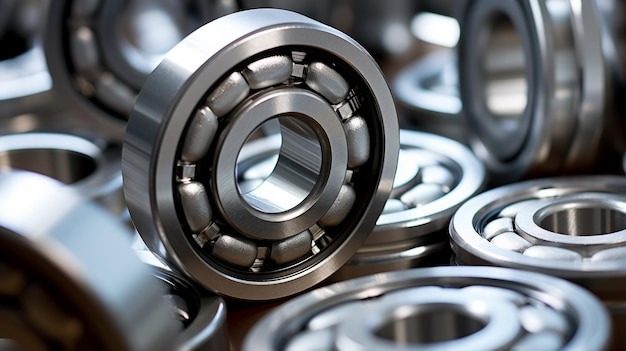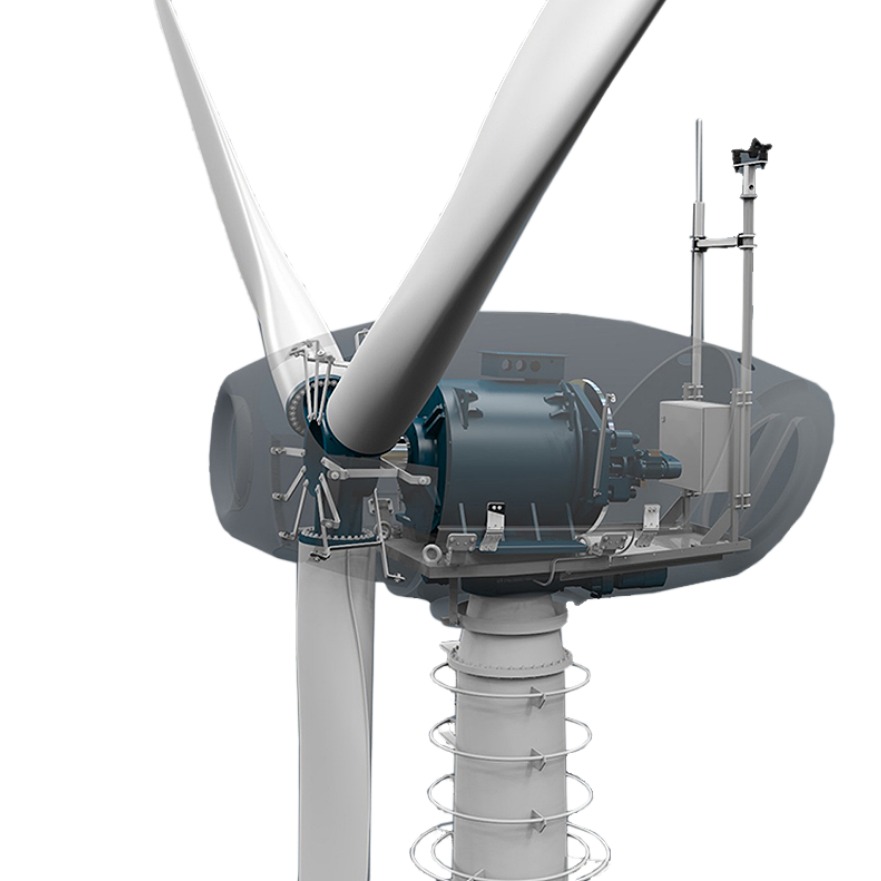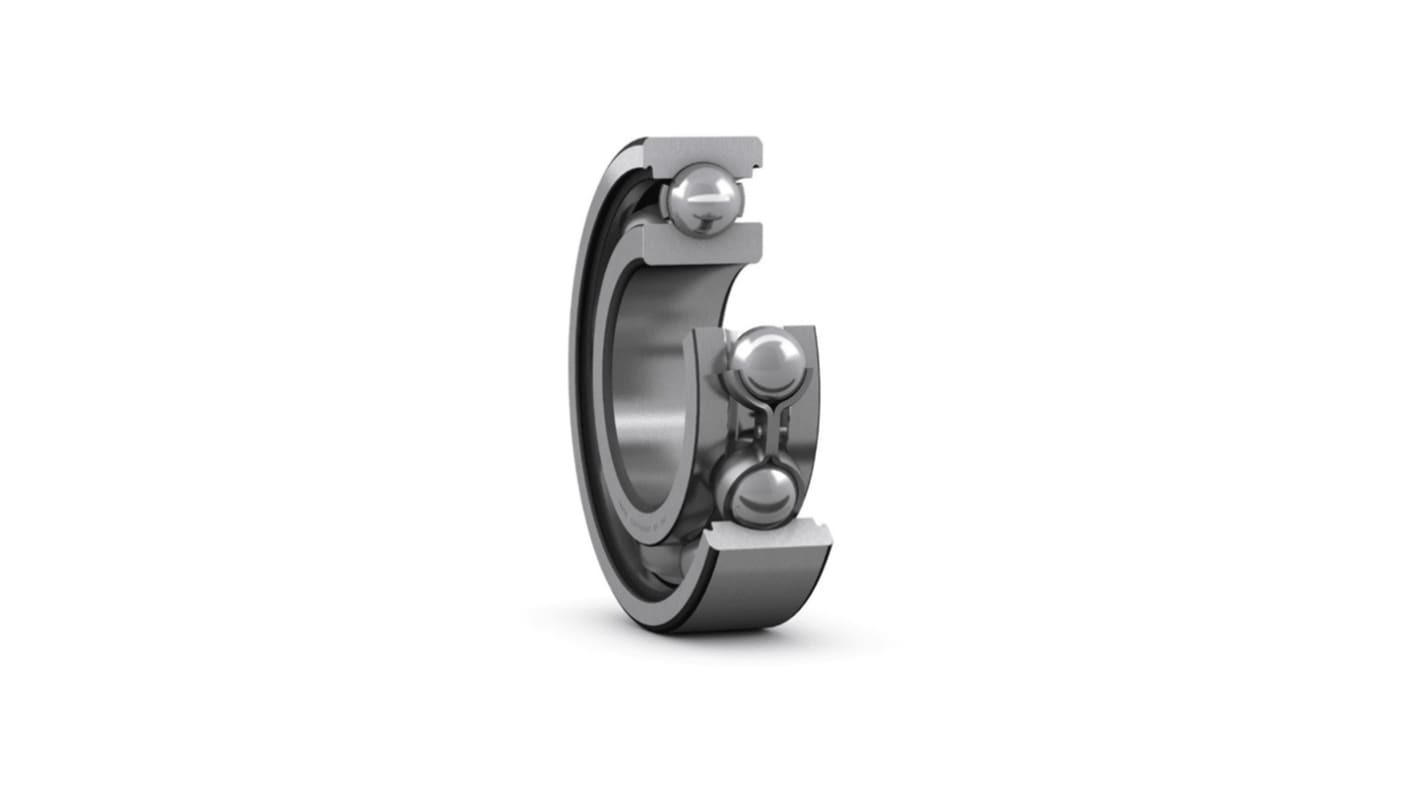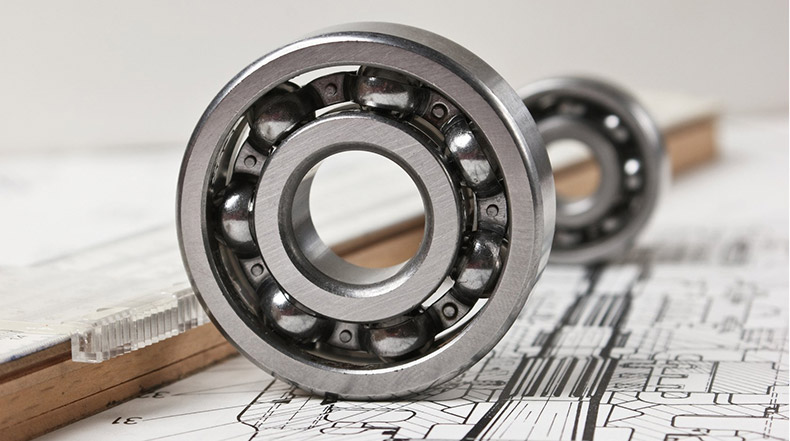Single-Row Deep Groove Ball Bearings: The Versatile Powerhouse of the Bearing World
Introduction: Single-Row Deep Groove Ball Bearings: The Versatile Powerhouse of the Bearing World
Single-row deep groove ball bearings (GB/T 276-2003), formerly known as single-row radial ball bearings, are the most widely used type of rolling bearings. Characterized by small frictional resistance and high speed, it can be used to bear radial load or radial and axial at the same time; the role of the joint load on the machine can also be used to bear the axial load on the machine. Single-row deep groove ball bearings are widely used in the industrial field because of their simple structure, wide range of applications, small frictional torque, and other characteristics. For example, small power motors, automobile and tractor gearboxes, machine tool gearboxes, general machines, tools, and so on.
The Anatomy of Single-Row Deep Groove Ball Bearings
Single-row deep groove ball bearings are one of the most representative structures of rolling bearings and are widely used. Its structure includes an outer ring, an inner ring, a set of steel balls, and a set of cages. The deep groove ball-bearing raceway cross-section is circular, and the radius is slightly larger than the radius of the rolling ball. This design makes the bearing withstand radial load and can also withstand two directions of axial load.

Key Components
Outer and inner rings: The raceways on the outer and inner rings are circular in cross-section, with a radius slightly larger than the radius of the rolling balls, and this design enables the bearings to withstand radial and axial loads.
Steel Balls: Steel balls are rolling bodies responsible for rolling between the inner and outer rings, transmitting force and motion.
Cage: usually use steel plate stamping cage, the material can be wave, crown, etc., suitable for single-row deep groove ball bearings. In addition, you can also use copper alloy or phenolic resin cut keep frame, synthetic resin molding keep frame.
Design Features
Single-row deep groove ball bearings are simple and easy to use. Their basic design includes open type and sealed type. Open-type bearings do not come with a sealing structure, while sealed-type deep groove ball bearings are divided into dustproof seals and oilproof seals. A dustproof seal cover is made of stamped steel plate, which is mainly used to prevent dust from entering the bearing raceway; an oil-proof type seal can effectively prevent the grease inside the bearing from overflowing.
Materials and Manufacturing
The materials of single-row deep groove ball bearings mainly include carbon steel, bearing steel, stainless steel, plastics, and ceramics. Among them, bearing rings and balls are usually made of GCR15 (AISI 52100) refined bearing steel, and the keepers are stamped from an 08F high-quality cold rolled steel strip. High-carbon chrome steel is suitable for high load and speed conditions, stainless steel is commonly used in wet or chemically corrosive environments, and ceramic materials such as alumina ceramics and silicon nitride oxide ceramics are suitable for high-speed, high-temperature, high-precision applications.
Advantages of Single-Row Deep Groove Ball Bearings
Single-row deep groove ball bearings offer a variety of advantages, such as low friction and high speed capability, versatility and comprehensive performance, and load handling versatility.

Versatility in Load Handling
Single-row deep groove ball bearings can not only withstand radial loads but also can withstand axial loads in both directions. This allows it to maintain good working performance under a wide range of operating conditions and is suitable for a variety of load requirements.
Low Friction and High-Speed Capability
The structural design of single-row deep groove ball bearings is the basis for their low friction and high-speed capability. These bearings consist mainly of inner and outer rings, steel balls, and cages in a simple and compact structure, which allows them to rotate with less friction and wear, resulting in higher speeds and lower energy consumption. In addition, single-row deep groove ball bearings have a low coefficient of friction, which is one of the key reasons for their low friction characteristics.
Secondly, the choice of material has an important impact on the performance of single-row deep groove ball bearings. For example, single-row deep groove ball bearings made of stainless steel have a lower coefficient of friction and a higher limiting speed, which enables them to maintain lower friction and higher efficiency at high speeds.
Finally, the lubrication method is also an important factor affecting the low friction and high-speed capability of single-row deep groove ball bearings. Some single-row deep groove ball bearings are filled with grease at the factory and can be lubricated for life without maintenance, which further reduces friction and extends bearing life.
Cost-Effectiveness and Availability
They are extremely common due to their simple structure, high manufacturing precision, ease of mass production, and low manufacturing costs. These bearings require little maintenance and can run for long periods without frequent replacement or lubrication. Single-row deep groove ball bearings are widely used in automobile, electrical, engineering machinery, railroad vehicles, agricultural machinery, and other fields, applicable to a variety of industrial machinery and equipment.
Versatility and comprehensive performance
Single-row deep groove ball bearings are the most widely used type of roller bearings in the world because of their versatility and comprehensive performance. They are characterized by deep raceway grooves, inner and outer rings in a circular arc with a radius slightly larger than the radius of the balls, and a non-separable ring structure.
Applications of Single-Row Deep Groove Ball Bearings
Single-row deep groove ball bearings are widely used in the automotive, aerospace industry, construction machinery, energy, and power generation industries, agriculture and construction equipment, household appliances and electronic products, and many other fields, such as rear wheels of automobiles, transmissions, electrical equipment components and so on.
Industrial Machinery and Manufacturing
Powering conveyor belts, pumps, and compressors in electric motors
- Supporting the rotating parts of the motor: deep groove ball bearings can support the rotating parts of the motor, such as the rotor, so that the rotating parts in the operation are smoother and reduce friction loss, thus improving the working efficiency of the motor.
- Reduce friction loss: Compared with other bearings, deep groove ball bearings have a smaller friction coefficient, which can reduce the friction loss between the rotating parts of the motor and the bearings and prolong the service life of the motor.
- Strong load bearing capacity: Deep groove ball bearings can withstand large axial and radial loads, suitable for high-speed rotation and high temperature and high-pressure environment of the motor.
Application in gearboxes
- Withstand joint load: Deep groove ball bearings can withstand radial and axial at the same time the role of the joint load, suitable for small power motors, automobile and tractor gearboxes, machine tool gearboxes, and so on.
- High speed: Due to its high speed and low frictional resistance, deep groove ball bearings are suitable for gearbox components that require high-speed rotation.
Automotive and Transportation
Single-row deep groove ball bearings are widely used in the automobile and transportation industry, mainly used in automobile suspension systems, transmission systems, wheel bearings, and other parts.
In automobile suspension systems, single-row deep groove ball bearings are used to support and connect the wheels with the body, withstand shocks and vibrations from the road surface, and ensure the smoothness and comfort of the vehicle. For example, deep groove ball bearings are often used in the rear wheel suspension system of automobiles to reduce vibration and noise. In the automobile transmission system, single-row deep groove ball bearings are used to transmit power, connecting the engine and transmission to ensure the smooth transmission of power. They can withstand high radial and axial loads, and are suitable for high-speed running environments, improving the transmission efficiency and reliability of vehicles.
Wheel bearings are important moving parts in automobiles, where single-row deep groove ball bearings play a supporting and rotating role to reduce friction and wear and prolong the service life of wheels. Their high rotational speed and low coefficient of friction make the wheels rotate more smoothly, improving vehicle maneuverability and fuel economy.

Aerospace and Aviation
Single-row deep groove ball bearings are widely used in aerospace, mainly used to support rotating shafts and transmissions to ensure the stability and reliability of aircraft. In aerospace, single-row deep groove ball bearings are widely used in the support and transmission of various rotating parts. Specific application scenarios include:
- Rocket and spacecraft servo systems: Bearings are mounted at various nodes and joints to support rotation and carry loads and are critical to controlling the rocket’s flight attitude.
- Satellites and other vehicles: Shafts and transmissions are used to support rotation and ensure the stability and reliability of the vehicle.
Home Appliances and Electronics
Single-row deep groove ball bearings have a wide range of applications in household appliances, mainly used in air conditioners, washing machines, refrigerators, microwave ovens, and other equipment.
Deep groove ball bearings bear the important load of fan bearings in air conditioners, which are used to support the motor and fan windings to ensure that the air conditioner can still provide a comfortable indoor environment under high-speed operation. In washing machines, deep groove ball bearings are widely used to support the rotation of the washing machine and drive the inner cylinder. It has the advantages of high bearing capacity, smooth movement, and low noise, which improves the stability and service life of the washing machine. The use of deep groove ball bearings in refrigerators is very important because it can ensure the smooth operation of refrigerators. Due to the large size of the refrigerator, the bearing capacity must also be relatively high, otherwise the service life of the refrigerator will be negatively affected.
Agricultural and Construction Equipment
Single-row deep groove ball bearings are widely used in agricultural and construction equipment and are mainly used as key components of support and transmission equipment.
- Applications for agricultural equipment:
Harvester: Deep groove ball bearings are used to support and drive the blades and conveyor system of the harvester and are capable of withstanding high shock loads, resisting dirt and moisture erosion, and ensuring long-term stable operation.
Cultivator: Used to support the cultivating parts of the cultivator, to withstand high loads and vibrations, to be resistant to mud and corrosion, and to ensure a smooth process of deep plowing and tilling of the soil.
- Applications for construction equipment:
Crane: Deep groove ball bearings are used in crane booms and pulley systems to withstand large radial and axial loads and ensure stable crane operation.
Excavator: It is used to support the bucket and arm of the excavator to withstand heavy loads and high rotational speeds to ensure the normal operation of the excavator.
Tower Crane: It is used for the rotating and lifting mechanism of the tower crane, bearing large radial and axial loads to ensure the stability and safety of the tower crane.
Energy and Power Generation
Wind Turbines: Gearboxes and transmission systems in wind turbines require highly reliable and long-lasting bearings. Single-row deep groove ball bearings are very suitable for use in wind turbines’ gearboxes and transmission systems due to their low friction, high speed, and long service life, ensuring the stable operation of the equipment. Solar photovoltaic equipment: The support and transmission system uses deep groove ball bearings to withstand large radial and axial loads. Their characteristics of high-temperature resistance, low friction, and high speed enable them to maintain good performance even in high-temperature environments.
The engine and transmission systems in oil-fired generators require high-performance bearings to ensure the stable operation of the equipment. Single-row deep groove ball bearings are suitable for use in the transmission system of oil-fired generators due to their high speed, low noise, and low vibration characteristics. Pumps and valves in nuclear power generation equipment need to withstand high temperatures and pressures. Deep groove ball bearings’ high-temperature resistance and low friction characteristics make them excellent in nuclear power generation equipment, ensuring the long-term stable operation of the equipment.

Selecting the Right Single-Row Deep Groove Ball Bearing
Selection of single-row deep groove ball bearings requires consideration of the following factors: load and speed, size and accuracy, and environmental factors, among others.
Load and Speed Considerations
Single-row deep groove ball bearings are mainly subject to radial loads but can also withstand some axial loads. Calculate the required load ratings according to the load conditions of the application scenario and select a bearing that can meet both radial and axial load requirements.
Dimensions and Accuracy
Dimensional specifications include inside diameter, outside diameter, and width. Selecting dimensions that meet design requirements ensures that the bearing can be accurately mounted in the equipment and provide sufficient load-carrying capacity. Gearboxes typically require high-precision bearings. Select the appropriate precision grade (e.g., P0, P6, P5) to ensure smooth operation and minimize vibration. At the same time, choose bearings with low noise and vibration to enhance the smoothness and comfort of equipment operation.

Environmental Factors
- Temperature: Temperature is one of the key environmental factors to consider when selecting bearings. High-temperature environments can cause the internal lubricant of the bearing to fail, increasing friction and wear and shortening the life of the bearing. Therefore, when selecting bearings, you need to ensure that they can operate stably within the expected operating temperature range.
- Humidity: The impact of humidity on bearings should not be ignored. A humid environment will lead to internal rust and corrosion of bearings, affecting their normal operation. Therefore, when selecting bearings, their rust and corrosion resistance should be considered to ensure that they can work properly in humid environments.
- Cleanliness: The cleanliness of the working environment also affects the service life of the bearings. Dust and impurities entering the inside of the bearing will lead to increased friction and accelerated wear. Therefore, choosing bearings with good sealing performance can effectively prevent the entry of dust and impurities and ensure the stable operation of bearings.
- Corrosive: In some industrial environments, corrosive substances can cause damage to bearings. Select bearing materials with corrosion resistance, such as stainless steel or special alloys, can effectively resist the erosion of corrosive substances and extend the service life of bearings.
Maintenance and Care for Single-Row Deep Groove Ball Bearings
Single-row deep groove ball bearing maintenance and maintenance should pay attention to the following aspects: cleaning and lubrication, regular inspection, cleaning methods, and sealed bearings, such as the use of precautions.
Cleaning and lubrication
In the course of use, deep groove ball bearings are subject to wear, and lubrication can slow down this wear and ensure bearing life. When selecting a lubricant, make sure it is compatible with the bearing and can resist wear in harsh environments. At the same time, keep the working environment clean and hygienic to prevent impurities such as dust, particles, and swarf from entering the inside of the bearings so as not to accelerate the wear of the bearings.
Regular Inspection
Maintaining the operation of deep groove ball bearings requires regular inspection and recording of relevant data. It is also necessary to clean and overhaul the bearings and related parts. When it is necessary to dismantle the deep groove ball bearings, the bearing housing, outer ring, sealing washer, locating pin and other parts should be completely dismantled. At the same time, deep groove ball bearings need to be rust-proofed to avoid long-term accumulation of dirt clogging the bearings.
Cleaning method
When cleaning deep groove ball bearings, neutral water-free diesel oil or kerosene can be used for immersion cleaning. If there are technical conditions, it is better to open the sealing cover for cleaning. After cleaning, empty dry cleaning oil, and appearance check for any damage. Rotate the bearings with appropriate tools (e.g., wooden stick) to check the rotation noise and wear.

Precautions for use of sealed bearings
Sealed deep groove ball bearings, such as those with dust caps on one side or seals on both sides, are usually maintenance-free products with lifetime lubrication. These bearings cannot be cleaned, and the temperature must not exceed 80 degrees. Bearings with seals can maintain proper working performance at ambient temperatures in the range of -30℃ to +100℃.
Conclusion: Maximizing the Potential of Single-Row Deep Groove Ball Bearings
In summary, single-row deep groove ball bearings have become one of the most widely used rolling bearings due to their simple structure, stable performance, and easy maintenance, and are suitable for a variety of industrial fields. Due to its low noise, low vibration, and high-speed characteristics, single-row deep groove ball bearings are especially suitable for occasions that require high reliability and long life. Purchasing suitable single-row deep groove ball bearings, paying attention to the mounting method, and maintaining the bearings daily can prolong the service life. Come to TFL Bearing Company to help you choose satisfactory deep groove ball bearings.
Frequently Asked Questions
- What are the main advantages of single-row deep groove ball bearings?
The main advantages of single-row deep groove balls include high-speed performance, radial load capacity, axial load capacity, low noise and low maintenance, structural versatility, and flexibility.
- How do single-row deep groove ball bearings differ from double-row bearings?
- Single-row deep groove ball bearings: These kinds of bearings have deep grooves on one side of the rolling body and cage only, the structure is relatively simple. This design makes single-row ball bearings have low friction and heat generation in high-speed operation, suitable for low load, high-speed operation occasions. However, its bearing capacity is relatively weak and not suitable for bearing large radial loads.
- Double-row deep groove ball bearings: these bearings have deep grooves and rolling elements on both sides, which make the structure more complicated. Therefore, double-row ball bearings can withstand higher radial load and are suitable for low- or medium-speed operation and high-load occasions. However, they may produce higher friction and heat generation at high-speed operation.
- Can single-row deep groove ball bearings handle both radial and axial loads?
Single-row deep groove ball bearings can withstand radial and axial loads. The design of this bearing makes it possible to withstand not only radial loads but also certain axial loads. When deep groove ball bearings are subjected to radial loads only, the contact angle is zero; when they are subjected to radial and axial loads at the same time, the contact angle will change, but they are still able to withstand both loads.
- How often should I maintain my single-row deep groove ball bearings?
Maintenance intervals for single-row deep groove ball bearings are usually once a year. This type of bearing is generally recommended for annual maintenance due to its long service life.
- Are single-row deep groove ball bearings suitable for high-speed applications?
Deep groove ball bearings are suitable for a certain range of high-speed occasions but need to be selected according to the specific speed range. In high-speed rotation occasions, deep groove ball bearings will be subject to centrifugal force and inertia force, so it is necessary to choose the deep groove ball bearings suitable for high-speed occasions. These bearings usually use high-precision manufacturing process and design, and the use of appropriate sealing design and lubrication, to ensure that it is high-speed and stable operation.
